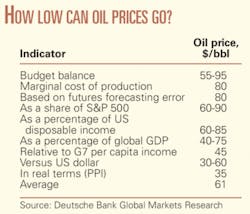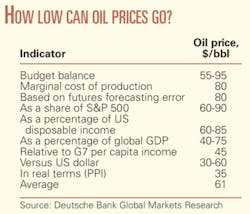Measuring ‘cheap’ oil
Oil prices have been on a downward spiral for several weeks, punched by dwindling demand. The price decline quickened as the credit crisis and resulting turmoil in the world’s financial markets sucked money out of commodities.
A special report by Deutsche Bank Global Markets Research addresses how low crude prices can slide given the slowdown in US and global economic growth. The report estimates that financial sector deleveraging and reduced credit availability could lower US GDP growth by up to 1.5 percentage points/year over the next 2-3 years.
In March—as prices were on the upswing—Adam Sieminski, chief energy economist for Deutsche Bank in New York, and Michael Lewis, the bank’s head of global commodities research in London, issued a similar report which examined the point at which oil prices could be considered extreme on the high side (OGJ Online, Mar. 17, 2008).
The report found that relative to per capita income, crude would have to reach $134/bbl to bring to 1981 levels the purchasing power of “an average G7 consumer” from the group of seven industrialized nations: Canada, France, Germany, Italy, Japan, the UK, and the US.
Downside price discovery
Sieminski and Lewis now believe the deepening banking crisis and the slowdown in global economic growth that lies ahead will continue to pressure commodity prices downward, most notably in energy and industrial metals.
Their new analysis finds that oil prices would have to fall to $35/bbl to bring prices in real terms back to their long-run historical averages. But they believe that important changes in the market, especially the geographic location of marginal supply and demand, suggest that $60/bbl represents a more realistic characterization of “cheap oil.”
But before oil reaches that level, they predict, OPEC will cut production to defend the price, and the group of exporters would need to make aggressive cuts, given the risk that global GDP growth will fall below 2% in 2009.
Indicators
As shown in the table, the analysts find the nadir for oil prices based on a series of measurements, such as the price of oil relative to per capita income and as a percentage of global GDP.
They examined how many barrels of oil could be purchased with respect to per capita income in the G7 countries and found that in 1970, oil was about $3.30/bbl and income averaged about $3,700, sufficient to buy 1,000 bbl/year of oil.
But in July, when crude futures peaked above $145/bbl, affordability dropped such that incomes could purchase only 307 bbl. So for crude oil affordability to return to its long-run average, the price would have to fall to $45/bbl, which would allow the average G7 consumer to buy just over 1,000 bbl of oil.
Deutsche Bank also looked at the oil price required to balance budgets in key oil exporting countries to provide insight into how low oil prices could go. Sensitivity of the oil price to government finances is different for every country.
The analysts note that it’s no surprise that as oil prices have fallen below $95/bbl, the price needed to balance the budgets of Venezuela and Iran, the rhetoric from those two countries has grown louder in calling for action to defend the price. The Deutsche Bank report finds that Saudi Arabia requires an oil price of $55/bbl to balance its budget, while Russia’s balancing point is $70/bbl.
As the table shows, given the various price indicators, Sieminski and Lewis determine that as long as economic growth is anemic and demand destruction risks continue to drive commodity prices lower, a price of about $60/bbl could represent an arresting point for crude.

